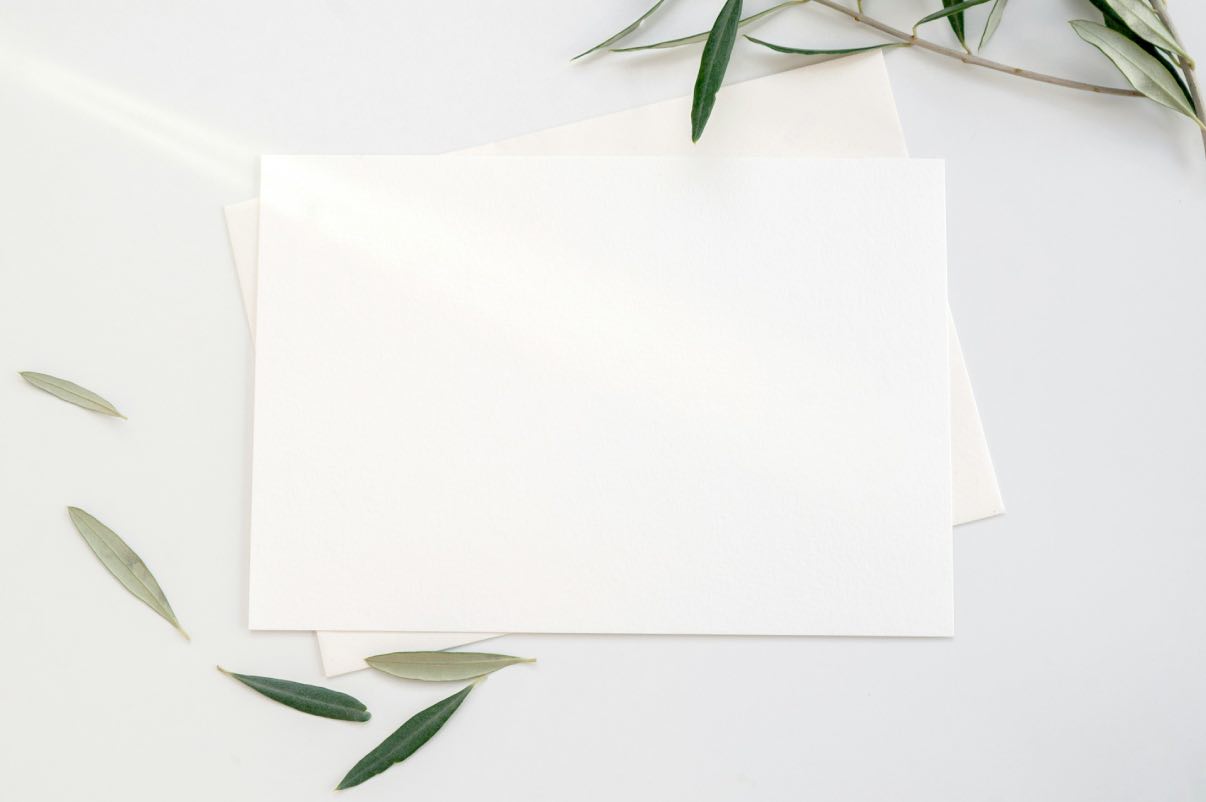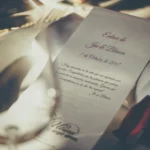Believe it or not, wedding invitation design costs can reach $550 for invitations and $350 for RSVP cards. Creative brides learning about wedding invitation design ideas have found that there was a budget-friendly alternative – they can design their own invitations.
Couples can create stunning invitations for just $60 per double-sided card with simple design skills and the right tools. Modern brides can choose from over 1,000 customizable templates or start from scratch to design an invitation that matches their style perfectly.
Creating custom wedding invitations might seem overwhelming at first. The right guidance turns this experience into an exciting chance to add your personal touch to the celebration. Couples will learn everything about designing their perfect wedding invitations in this piece, from selecting the right elements to preparing the final files for production.
Contents
- 1 Wedding Invitation Design Basics
- 2 How to Plan Custom Wedding Invitation Design
- 3 Essential Design Tools and Materials
- 4 Creating Your Wedding Invitation Design
- 5 Testing and Finalizing Your Design
- 6 Wedding Invitation Design Frequently Asked Questions
- 6.1 Is it cheaper to design your own wedding invitations?
- 6.2 How to design an invitation card for a wedding?
- 6.3 How long before the wedding should you send invitations?
- 6.4 What is the average cost of 100 wedding invitations?
- 6.5 What size should a wedding invitation be?
- 6.6 What is the best way to make an invitation?
- 6.7 What paper should wedding invitations be on?
- 6.8 When should you start designing wedding invitations?
- 6.9 How do you structure a wedding invitation?
Wedding Invitation Design Basics
Wedding invitations give guests their first real peek at what the couple’s special day will be like. They set the mood for the celebration that’s coming. A well-laid-out invitation suite brings together several key pieces that create an elegant package.
Key Elements of Invitation Design
The foundation of any wedding invitation suite rests on its basic pieces. A traditional suite has:
- Main invitation card (typically 5×7 inches) with names and event details
- Response cards (4.75×3.5 inches) for guest count and meal priorities
- Small enclosure cards (3.5×4 inches) with extra event details
- Large enclosure cards that explain destination wedding specifics
- Inner and outer envelopes with elegant liners
Popular Wedding Invitation Styles
Couples should think about their style before they start looking at wedding invitation designs. Classic floral patterns and die-cut details never go out of style. Modern trends lean toward doodle-style stationery and illustrations inspired by the venue. Brush lettering has become a fresh take on traditional calligraphy while keeping its artistic flair.
Setting Your Design Direction
The invitation design should capture the wedding celebration’s overall theme and style. Couples need to pick colors, fonts, and images that match their vision. The design process also involves choosing the right materials and printing methods to create that premium feel they want.
Personal touches make invitation designs special and tell the couple’s unique story(See Taylor Kinney’s wedding). A consistent design throughout all pieces creates an invitation suite that leaves a lasting impression. Information should flow naturally on the page, with important details like names, date, and venue standing out while everything stays visually balanced.
How to Plan Custom Wedding Invitation Design
Creating wedding invitations that feel personal starts with good planning and eye for detail. Three elements are the foundations of a design that captures your celebration’s spirit.
Choosing Your Color Palette
Colors set the visual tone for wedding invitations. A good color scheme should match both the season and setting of your celebration. To cite an instance, winter ceremonies look better with deeper hues, while spring celebrations work well with pastels. Your venue’s colors should blend into your invitation design.
Pick one or two main colors as focal points and add one or two supporting shades with a neutral tone for balance. Gold or silver accents can improve the design when you don’t use too much of either throughout the suite.
Selecting Typography and Fonts
Typography says more than just words—it shows the style and formality of your celebration. These basic styles work well:
- Serif fonts: Perfect for traditional ceremonies, featuring elegant finishing strokes
- Sans serif fonts: Ideal for modern, minimalist designs
- Script fonts: Suited for romantic, classic esthetics
Your invitations will look best with two fonts that go together. Save decorative fonts for headlines or couples’ names and keep the important details in clear, readable text.
Creating a Cohesive Design Concept
A wedding invitation is part of your celebration’s overall look. The design should naturally fit with other wedding elements, from cake decoration to venue esthetics. Designers call this the wedding’s “brand identity”.
Pantone colors help keep your printed materials consistent. This way, all your wedding stationery matches perfectly. Your invitation gives guests their first peek at your wedding style, so pick elements that show what your special day will feel like.
Note that text and background colors need good contrast to stay readable. Light ink on light backgrounds or dark ink on dark backgrounds makes reading difficult, so make sure all important details stand out clearly.
Essential Design Tools and Materials
The right tools and materials are the foundations of successful wedding invitation design. Couples need both digital and physical resources to bring their vision to life.
Digital Design Software Options
Adobe Creative Suite leads the industry standard for professional invitation design with three key programs: Illustrator for vector graphics and smooth outputs, Photoshop for image editing, and InDesign for layout work. Designers can access the complete suite for about USD 60 per month instead of buying individual programs. Canva is a great alternative that provides an intuitive platform with many templates and design elements that works well for beginners.
Required Art Supplies for Physical Design
A paper cutter is essential and costs under USD 15, while replacement blades are USD 3. This tool saves hours compared to cutting by hand. Double-sided tape and glue dots give clean, professional results when you’re assembling layers and adding envelope liners.
Your paper choice will affect the final presentation a lot. Uncoated cardstock creates a luxurious look and stays durable, especially when you have cotton, linen, or felt finishes. Specialty paper stores can help you pick the right sizes and weights that work with home printers.
Printing Resources and Requirements
Most home printers can handle cardstock up to 80 pounds. You should test prints on sample papers before you commit to bulk printing. Professional print shops give you more options, including:
- Digital printing for standard invitations
- Letterpress for textured, premium finishes
- Foil stamping for metallic accents
A clever tip is to number RSVP cards with invisible ink. This helps track responses when guests forget to add their names. A light mist of setting spray stops ink transfer and color bleeding during mailing.
If you choose home printing, proper printer settings and calibration will give consistent color reproduction. Matte finish papers usually produce better results than glossy options that need more drying time.
Creating Your Wedding Invitation Design
A systematic approach combines artistic vision with technical expertise to transform wedding invitation designs from imagination to reality. The experience starts with simple sketches and grows through digital refinement to create the perfect invitation suite.
Sketching Original Concepts
The creative process begins with pencil sketches that focus on simple layout and design elements. Many designers prefer computers, but hand sketching lets you explore multiple concepts quickly without technical distractions. Of course, this helps you picture different ways to showcase the wedding style through invitation design.
Your sketches should focus on these design elements:
- Text placement and hierarchy
- Decorative borders or illustrations
- Space for monograms or custom artwork
- Integration of cultural or personal symbols
Developing Digital Mockups
The next phase creates digital mockups after finalizing the original concept. These visual representations show couples how their invitations will look in ground reality. Digital mockups display various elements like printing effects, color combinations, and paper textures.
Mockups let you explore different color options, printing techniques, and typeface combinations. Couples can make informed decisions about design elements before final production. Digital visualization tools show how elements like ribbons, velvet accents, and unique silhouettes appear in the finished product.
Refining Your Final Design
Detailed review sessions and careful adjustments ensure every element arranges perfectly with the couple’s vision. This stage confirms layout accuracy, checks text placement, and verifies that all design elements work together harmoniously.
Professional designers include two rounds of revisions in this phase. This approach helps realize the design’s full potential through thoughtful iteration. The final design goes through careful proofreading to eliminate errors before production begins.
Expert Tip: Your wedding invitation’s success depends on meticulous attention to detail during refinement. Take time to ensure every element matches your vision and expectations.
Testing and Finalizing Your Design
The final phase of wedding invitation design needs careful attention to detail and quality control. This stage will give a professional finish to every element of the custom wedding invitation design before mass production starts.
Printing Test Samples
Perfect wedding invitations begin with printing test samples. Without doubt, a printed sample of the actual invitation helps verify paper quality and print accuracy. Most professional printing services offer sample printing options to match the final product with expectations.
Test prints help check color balance and text legibility. You should check these prints under different lighting conditions to see if colors look right. Professional designers suggest a 4-6 week window for this testing phase. This timeframe creates room to handle adjustments and unexpected issues.
Feedback and Making Adjustments
Feedback from different sources is a great way to get the design perfect. Yes, it is best to have several people look at the proofs, especially when you have people with strong language skills or eye for detail. This method catches errors that might slip through unnoticed.
The proof review should focus on these key elements:
- Text accuracy and spelling
- Date and time details
- Venue information clarity
- Overall design harmony
- Print quality consistency
Keep making adjustments through unlimited proofing rounds until feedback shows perfection. A detailed record of each revision helps track systematic improvements.
Preparing Files for Production
File preparation for professional printing comes last. This process needs specific technical steps to get the best results. Digital printing files must use CMYK color mode with 300 DPI minimum resolution.
Expert Tip: Save the final design as a PDF format, which maintains higher print quality compared to JPEG files.
Designs with bleeds need all elements touching the edge to extend 1/8 inch beyond the trim line. This requirement creates clean edges after cutting. Professional print shops want vector PDF files with proper bleed settings to get optimal results.
Standard printing services take 2-3 business days. Letterpress or specialty printing methods need extra time because they use custom plates or dies. Note that you should weigh a complete sample invitation with all enclosures at the post office to find the right postage.
Wedding Invitation Design Frequently Asked Questions
Is it cheaper to design your own wedding invitations?
Yes, designing your own wedding invitations can often be cheaper, especially if you’re creative and have the time to dedicate to the project. By opting for a DIY approach, you can save money on professional fees and materials by sourcing them yourself. However, remember to factor in costs like printing and supplies to ensure your wedding invitation design stays within budget.
How to design an invitation card for a wedding?
To design an invitation card for a wedding, start by deciding on the theme or style that matches your wedding design. Select fonts, colors, and layouts that complement your overall aesthetic. If you’re wondering how to design a wedding invitation, templates can be a great starting point, or you can use design software for a more custom approach.
How long before the wedding should you send invitations?
Wedding invitations should be sent out around six to eight weeks before the wedding date. This timeline gives your guests enough time to RSVP and make any necessary travel arrangements. If your wedding is a destination event, consider sending save-the-dates earlier to ensure ample planning time.
What is the average cost of 100 wedding invitations?
The average cost of 100 wedding invitations can range from $200 to $500, depending on the materials and complexity of the wedding invitation card design. High-end options with custom elements or specialty paper can increase the cost. Keep in mind that DIY invitations or digital options can help you stay under budget.
What size should a wedding invitation be?
Wedding invitations are typically 5×7 inches, a classic and elegant size that fits easily into standard envelopes. However, you can explore other sizes depending on your wedding design, such as square or elongated formats, to make a bold statement. Just ensure your chosen size accommodates postage requirements.
What is the best way to make an invitation?
The best way to make an invitation is by balancing creativity with practicality. Start with a clear vision of your wedding theme, and incorporate it into the design. Use tools like Canva or Adobe InDesign for a polished result, or work with a professional to elevate your wedding invitation design.
What paper should wedding invitations be on?
Wedding invitations are traditionally printed on thick, high-quality cardstock or specialty paper. Popular options include textured linen, cotton, or vellum, as they add an elegant touch to the overall wedding invitation card design. Your choice of paper can greatly influence the invitation’s look and feel.
When should you start designing wedding invitations?
Start designing wedding invitations at least four to six months before your wedding. This allows enough time for revisions, printing, and addressing envelopes. Early planning ensures your wedding invitation design reflects your theme and is ready to send out on schedule. If your guests will RSVP online, thinking of wedding email address ideas is recommended at this time.
How do you structure a wedding invitation?
A wedding invitation should be structured with key details like the names of the couple, the date, time, venue, and RSVP information. Begin with a welcoming phrase, followed by the essential details in a clear and organized layout. A well-thought-out structure enhances your wedding invitation design and ensures guests have all the information they need.




